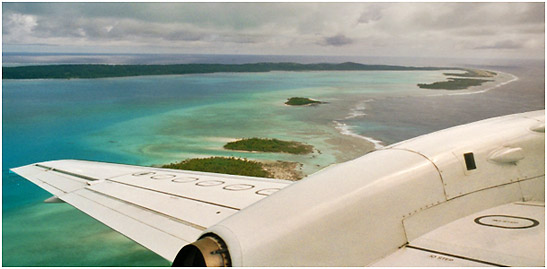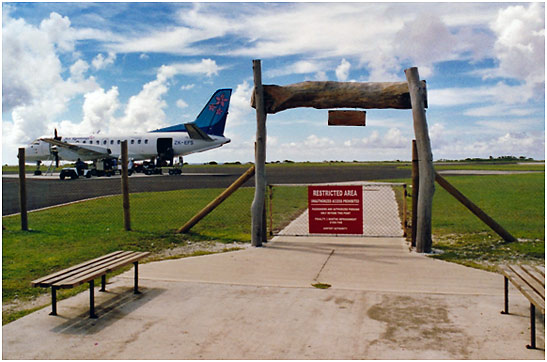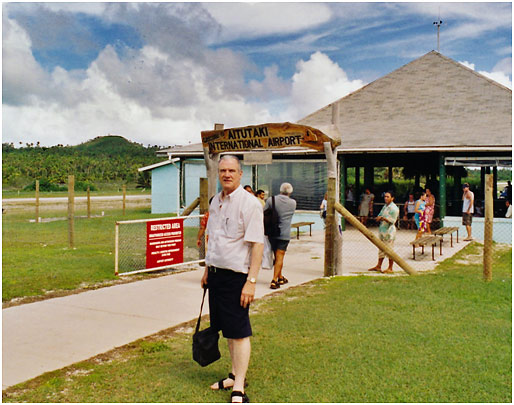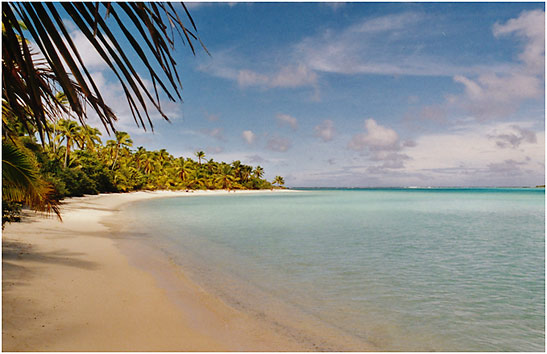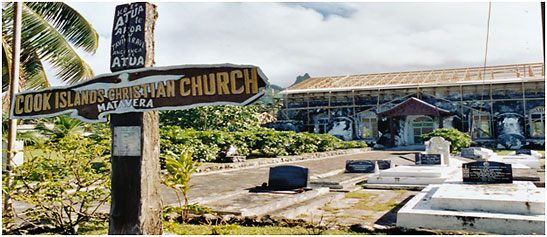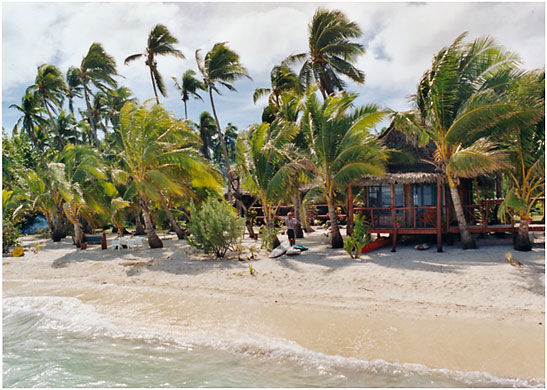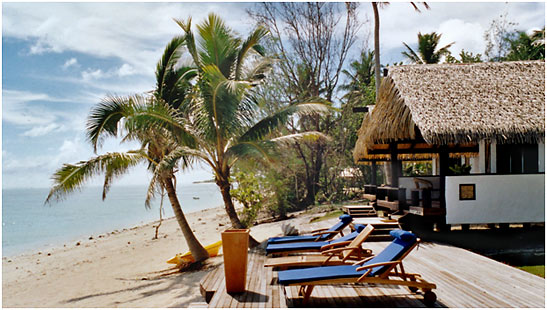|
Is This the World's
Most Beautiful Island? Words and photos by John Clayton
Even with all my travels, I'd heard of the Cook Islands, but I'd no idea WHERE they are. And for sure, I had no idea at all where Aitutaki could be. It's pronounced AYE TWO TARKI, and it's one of the 15 Cook Islands. These enchanting, gorgeous and stunning collection of small islands, cover an incredible area of 92 square miles of the South Pacific Ocean, northeast of New Zealand, between French Polynesia and American Samoa. Got it? Equally inconceivable is that these islands are spread out over an expanse of our world encompassing 2 million miles of ocean. Popular? You bet, because from 2010 to 2011 over 100,000 tourists visited the intriguing, beguiling, spellbinding Cook Islands. The island of Rarotonga, and its airport, are the main port of entry, and arriving there by air is a thrill. As your Air New Zealand 767 gets lower and lower over the ocean for the landing, you're sure (for just a second or two!) that the aircraft is going to touch down on the Pacific itself! Not so, as the huge Boeing gently touches the airport runway that seems to be just inches from the water's edge. While my stay in Rarotonga was fascinating, the more I heard about Aitutaki, the more I wanted to go there. The distance from Rarotonga to Aitutaki is 163 miles, and the flight takes 45 minutes. Now you know from reading my travel adventures I'm NOT a so called "White Knuckle" flyer. I love it, but the fact is that as I boarded the Air Rarotonga Saab 340 I noticed it had two (in my mind) small engines to carry us over all that water. Truth be told, yes, I was just a teeny, weeny bit, well apprehensive. The reality is that it was a superb trip, comfortable and with countless flights all over that part of the Pacific area since 1978, Air Rarotonga has flown hundreds of thousands of passengers safely and securely.
The word paradise is, in my view, such an overused word by travel journalists, but I must tell you that word is meant for Aitutaki. As our Air Rarotonga aircraft lowered the gear for our landing in Aiututaki, I glimpsed the gorgeous, long sandy beaches that were so white I thought for a second or two they'd been bleached. Aitutaki, encased by waters so blue and green it dazzled my eyes with sparkling hues and a brilliance given only to diamonds – I was now completely convinced that this was indeed paradise, or at the very least, the place that gave the world the name paradise.
I've always liked – as the Brits say –"chatting up the locals" on any place I've visited, and while strolling around Aitutaki's (now get THIS!) International Airport, I got into conversation with what I can only call "a grizzled old timer" who looked to me to be at least 80 years of age, but he had such an intriguing, time worn fascinating face, I felt sure he knew the history of even the smallest lagoon, and could tell you in an instant, how old each palm tree was on the island. It was astonishing that he knew, and understood English – perfectly. I had to find out from someone how on earth this sort of jungle shack, open to all the elements of the weather, and without any of the luxuries of a modern airport, could be called an International one. And I was sure he'd have an answer. Although what he told me satisfied my curiosity, his next comments intrigued me. He asked if I was an aviation aficionado. It seemed such an out-of-the-blue question that I knew I'd made the right decision to engage him in conversation. "You should take the Bishops Cruises Catamaran out to an island called Akaimi," he said. Curious, I asked why? He looked at me for at least a minute or more, paused and, turning his head, eyes and gaze toward the ocean, said "when you get over to Akaimi Island you'll find some wonderful old relics of the famous Coral Route, and the splendid flying boats that flew this TEAL service all those many years ago now." With a curiosity born of years of asking questions in my radio and TV shows, I could not leave this fellow until I'd found out how he knew and spoke English so well. Back in 1821 many missionaries from Great Britain arrived here (as an ex-Brit myself, I'm sure they left to escape England's dreadfully cold winters) and as a result, Christianity took hold in the culture. Many islanders, to this day, continue to be Christian believers, and my new found "friend" was, it turned out, descended from one of those British missionaries.
As an aviation aficionado I'd heard of the Coral Route, and knew that he was talking about Tasman Empire Airlines Limited. In the early 1950s up to the very early 1960s, they flew Short (Sunderland) Solent flying boats. These were what are now regarded as the classic, really elegant flying boats powered by 4 Bristol Hercules 733 engines, and they cruised along at a leisurely 273 mph. Back then flying was only for the rich and famous, and this (in my view) marvelous Bird-of-the-Skies only carried 24 passengers who had day and night accommodations, or it could lodge 36 Day passengers. Either way, it was the pinnacle of luxury, with four cabins on the lower deck, and two on the upper; there was a lounge/dining area (linen table clothes, fine crystal china when meals were served, all prepared "made to order" in the aircraft's kitchen) the lower deck had two dressing rooms, and 3 "rooms" for freight. It was, as one frequent traveler depicted it, "Like the Ritz Hotel – except it flew." The only downside to all this luxury and inflight pampering, was that it could not make the flight from New Zealand to Tahiti nonstop – it had to refuel in, you guessed it, Akaimi. The passengers, when contrasted with today's almost cattle car handling, were treated like royalty. They were taken off the flying boat in a launch (or Tender as it was called) or were able to walk off onto a pier as it was at the refueling stop on Akaimi Island. Here they rested in what an islander told me was "qualified luxury, and yes, they were still indulged." As our Bishops' Catamaran drew near to the shoreline, the skipper – who I felt sure, was an aviation buff – and in a voice that was filled with pride, shared with us that the "re-created terminal can be seen on the shore, just ahead. The actual pier can, incredibly, still be seen, even though it's a bit rusty."
Surrounded on all sides by lush, greener than green jungle; with the turquoise waters only a few peaceful steps away, and sounding like a soothing classical music concert as it lapped at the white sandy beach, I saw why – back then – everyone who flew aboard these magnificent machines, was urged, as noted in one of TEAL's brochures, "Please be advised we suggest you bring your bathing suits." Of all the captivating destinations around the world that work (as a travel journalist) allowed me to visit, Aitutaki is the most relaxing, stunning, restful, gorgeous, and tranquil. It's exactly the type of place you feel sure MIGHT exist somewhere in the world – because tourist brochures imply that such faraway places – with such an abundance of jaw dropping scenery – really do exist. But when YOU actually get to see it up close and personal yourself, your mind is swept up in a sort of dreamlike sequence where you're still not sure if this IS reality, or if your dreams of a perfect vacation are still just that – a dream. For me, Aitutaki was a reality I never wanted to end. So, if you've "Been there and done that," and if you're still wondering WHERE to go next, make your reservations for Aitutaki – now. Its nirvana, bliss, joys unknown and Cloud Nine Ecstasy all rolled into one. Go to Wikipedia and check out Aitutaki; the Cook Islands, and Air Rarotonga.
Let me close this by sharing with you some "Oh, I didn't know that information." If you love, as I do, the CBS TV series Survivor, the 2006 series used Aitutaki as the setting for the famous Tribal Council sequences. In 2001 Steve Fosset passed over it on his around the world flight in his balloon Solo Spirit. It's also home to the oldest Church (!) in the Cook Islands – when I saw it, I was instantly reminded of very old churchyards in England – and it's so weird to see THAT in a South Pacific Island!!! Equally remarkable and extraordinary is (now get THIS name!) One Foot Island! In 2010 the well regarded Lonely Planet Travel Guide nominated Aitutaki as "The World's Most Beautiful Island," The TEAL flying boat ARANUI that flew this route was, thank goodness saved, and is on display in the Museum of Transport and Technology in Auckland, New Zealand. I've said this before, but if you're looking for new, offbeat places to visit around the world, or enjoy places that you thought you knew, and wanted a different and creative insight into, be sure you make time in your day to read my Travel With A Difference features right here. Until then, Happy Travels. Related Articles: |
